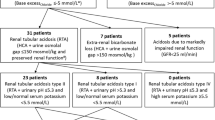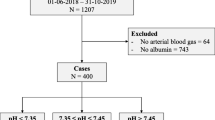Abstract
Purpose
We aimed to clarify the acid-base abnormalities of patients with acute kidney injury (AKI) requiring peritoneal dialysis (PD) in pediatric cardiac care units.
Methods
A retrospective observational study was conducted in a pediatric cardiac care unit in a tertiary care university hospital. The subjects were 40 patients with AKI requiring PD between 2003 and 2005, and controls matched by type of surgery and body weight. Acid-base variables, including blood gas data and electrolytes, were assessed. The Stewart-Figge variables, including strong ion difference apparent (SIDa), strong ion difference effective (SIDe), and strong ion gap (SIG), were calculated.
Results
Blood gas analyses showed that the PD group was more acidemic, with a lower mean bicarbonate and a lower mean base excess, typical features of metabolic acidosis. The strong ion analyses revealed that the PD group had lower mean sodium and albumin concentrations. Based on the Stewart-Figge methodology, SIDa was smaller in the PD group than in the control group, but SIG was similar in the two groups. Receiver-operating characteristic curve analyses showed that serum albumin was the only prognostic factor associated with PCCU mortality, even after adjustment for PD treatment.
Conclusion
Patients with AKI requiring PD in a pediatric cardiac care unit had significant metabolic acidosis compared to controls matched by the type of surgery and body weight. Hyponatremia and hypoalbuminemia were characteristics of these patients. The calculated SIDa was smaller in the PD than in the control group. Only the serum albumin had a significant prognostic value.
Similar content being viewed by others
References
Vachvanichsanong P, Dissaneewate P, Lim A, McNeil E. Childhood acute renal failure: 22-year experience in a university hospital in southern Thailand. Pediatrics. 2006;118:e786–791.
Flynn JT. Causes, management approaches, and outcome of acute renal failure in children. Curr Opin Pediatr. 1998;10:184–189.
Morris KP, Butt WW, Karl TR. Effect of peritoneal dialysis on intra-abdominal pressure and cardio-respiratory function in infants following cardiac surgery. Cardiol Young. 2004;14:293–298.
Boigner H, Brannath W, Hermon M, Stoll E, Burda G, Trittenwein G. Golej J. Predictors of mortality at initiation of peritoneal dialysis in children after cardiac surgery. Ann Thorac Surg. 2004;77:61–65.
Dittrich S, Vogel M, Dahnert I, Haas NA, Alexi-Meskishvili V, Lange PE. Acute hemodynamic effects of post cardiotomy peritoneal dialysis in neonates and infants. Intensive Care Med. 2000;26:101–104.
Kaplan LJ, Kellum JA. Initial pH, base deficit, lactate, anion gap, strong ion difference, and strong ion gap predict outcome from major vascular injury. Crit Care Med. 2004;32:1120–1124.
Balasubramanyan N, Havens PL, Hoffman GM. Unmeasured anions identified by the Fencl-Stewart method predict mortality better than base excess, anion gap, and lactate in patients in the pediatric intensive care unit. Crit Care Med. 1999;27:1577–1581.
Stewart PA. Modern quantitative acid-base chemistry. Can J Physiol Pharmacol. 1983;61:1444–1461.
Figge J, Mydosh T, Fencl V. Serum proteins and acid-base equilibria: a follow-up. J Lab Clin Med. 1992;120:713–719.
Figge J, Rossing TH, Fencl V. The role of serum proteins in acid-base equilibria. J Lab Clin Med. 1991;117:453–467.
Rocktaschel J, Morimatsu H, Uchino S, Ronco C, Bellomo R. Impact of continuous veno-venous hemofiltration on acid-base balance. Int J Artif Organs. 2003;26:19–25.
Rocktaeschel J, Morimatsu H, Uchino S, Goldsmith D, Poustie S, Story D, Gutteridge G, Bellomo R. Acid-base status of critically ill patients with acute renal failure: analysis based on Stewart-Figge methodology. Crit Care. 2003;7:R60–R66.
Rocktaeschel J, Morimatsu H, Uchino S, Bellomo R. Unmeasured anions in critically ill patients: can they predict mortality? Crit Care Med. 2003;31:2131–2136.
Kellum JA. Determinants of blood pH in health and disease. Crit Care. 2000;4:6–14.
Fencl V, Jabor A, Kazda A, Figge J. Diagnosis of metabolic acidbase disturbances in critically ill patients. Am J Respir Crit Care Med. 2000;162:2246–2251.
Kellum JA, Kramer DJ, Pinsky MR. Strong ion gap: a methodology for exploring unexplained anions. J Crit Care. 1995;10:51–55.
Jenkins KJ, Gauvreau K, Newburger JW, Spray TL, Moller JH, Iezzoni LI. Consensus-based method for risk adjustment for surgery for congenital heart disease. J Thorac Cardiovasc Surg. 2002;123:110–118.
Al-Radi OO, Harrell FE, Jr, Caldarone CA, McCrindle BW, Jacobs JP, Williams MG, Van Arsdell GS, Williams WG. Case complexity scores in congenital heart surgery: a comparative study of the Aristotle Basic Complexity score and the Risk Adjustment in Congenital Heart Surgery (RACHS-1) system. J Thorac Cardiovasc Surg. 2007;133:865–875.
Larsen SH, Pedersen J, Jacobsen J, Johnsen SP, Hansen OK, Hjortdal V. The RACHS-1 risk categories reflect mortality and length of stay in a Danish population of children operated for congenital heart disease. Eur J Cardiothorac Surg. 2005;28:877–881.
Upadhyay A, Jaber BL, Madias NE. Incidence and prevalence of hyponatremia. Am J Med. 2006;119:S30–S35.
Oren RM. Hyponatremia in congestive heart failure. Am J Cardiol. 2005;95:2B–7B.
De Luca L, Klein L, Udelson JE, Orlandi C, Sardella G, Fedele F, Gheorghiade M. Hyponatremia in patients with heart failure. Am J Cardiol. 2005;96:19L–23L.
Binanay C, Califf RM, Hasselblad V, O’Connor CM, Shah MR, Sopko G, Stevenson LW, Francis GS, Leier CV, Miller LW. Evaluation study of congestive heart failure and pulmonary artery catheterization effectiveness: the ESCAPE trial. JAMA. 2005;294:1625–1633.
Story DA, Morimatsu H, Bellomo R. Hyperchloremic acidosis in the critically ill: one of the strong-ion acidoses? Anesth Analg. 2006;103:144–148.
Kellum JA, Song M, Almasri E. Hyperchloremic acidosis increases circulating inflammatory molecules in experimental sepsis. Chest. 2006;130:962–967.
Gunnerson KJ, Saul M, He S, Kellum JA. Lactate versus nonlactate metabolic acidosis: a retrospective outcome evaluation of critically ill patients. Crit Care. 2006;10:R22.
Eisenhut M. Causes and effects of hyperchloremic acidosis. Crit Care. 2006;10:413; author reply 413.
Schafer M, Von Ungern-Sternberg BS, Wight E, Schneider MC. Isotonic fluid absorption during hysteroscopy resulting in severe hyperchloremic acidosis. Anesthesiology. 2005;103:203–204.
Konstam MA. Colloid osmotic pressure: an under-recognized factor in the clinical syndrome of heart failure. J Am Coll Cardiol. 2003;42:717–718.
Arques S, Ambrosi P, Gelisse R, Luccioni R, Habib G. Hypoalbuminemia in elderly patients with acute diastolic heart failure. J Am Coll Cardiol. 2003;42:712–716.
Kellum JA. Acid-base physiology in the post-Copernican era. Curr Opin Crit Care. 1999;5:429–435.
Author information
Authors and Affiliations
About this article
Cite this article
Morimatsu, H., Toda, Y., Egi, M. et al. Acid-base variables in patients with acute kidney injury requiring peritoneal dialysis in the pediatric cardiac care unit. J Anesth 23, 334–340 (2009). https://doi.org/10.1007/s00540-009-0747-2
Received:
Accepted:
Published:
Issue Date:
DOI: https://doi.org/10.1007/s00540-009-0747-2




